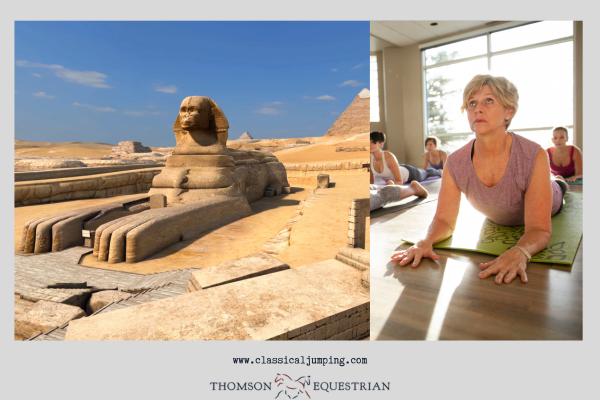
The Hidden Effort Behind Every Jump: Why Rider Balance Matters
The Hidden Effort Behind Every Jump: Why Rider Balance Matters
When we think about jumping, it's easy to focus on our horse’s athleticism—how high they can jump, how fast they can go. But there’s something we often overlook: how much effort they put in just to carry us over those fences.
Horses don’t have collarbones like we do to help hold up their front end. They rely completely on their muscles, tendons, and ligaments to support their head, neck, and ribcage. Add the weight of a rider on top of that, plus the challenge of jumping, and suddenly our balance becomes incredibly important.
The Anatomy of a Jump
Most riders don't realise how much work it takes for a horse to get all four feet off the ground. With no solid bone connection between their front legs (including shoulders) and the rest of their body, the horse’s entire front end is held up by soft tissue.
Now, imagine what happens when we head towards a jump. We’re sitting on their forward ribs, often leaning ahead ourselves—just when they need their front end to be as light as possible to lift off the ground.
Leaning forward too soon is one of the biggest mistakes riders make. Whether you're riding on the flat or approaching a fence, your shoulders should never get ahead of your knees. Think of it like this: your centre of gravity (behind your belly button) needs to stay right above your horse’s centre of gravity (near where the saddle flap and girth meet).
When your horse actually takes off, your shoulders might move in front of your knees, but that’s not because you’re tipping forward. It’s because your horse is changing their angle to the ground. If you’re jumping a big fence, the horse gets closer to vertical on their hind legs. Naturally, that shifts the rider’s position too. But over smaller jumps, this shift is much less obvious.
A lot of riders think they need to lean forward to jump—probably because most jumping photos capture riders in that position at take-off. Ask a group of pony club kids what they think is most important in their jumping position, and many will tell you, “lean forward!” But the 3 things missed that are way more important are 1: having a solid leg position, 2: staying balanced, and 3: putting their hands forward.
During landing, the correct position is quite the opposite of leaning forward. But it's still jumping position! Your feet should be forward, your body upright, and your hands extending to keep soft contact. Your centre of gravity stays aligned with your horse’s, ensuring both of you land safely and in balance.

Why Your Balance Matters
Your balance isn’t just about looking pretty in the saddle. It plays a huge role in your horse’s comfort and performance. Off-the-horse exercises can really help with this. For me, yoga has made a big difference. One of the hardest poses (hardest for me ;) I do is called Sphinx. You lie face down, lift your ribs, and support yourself on your forearms. Holding that pose for a couple of minutes gives me a real sense of how much core stability it takes—something similar to what a horse experiences when carrying us. Now, imagine your horse trying to do all that while jumping with the weight of a rider and saddle. Without collarbones to help, they rely on their balance and ours to make the jump as smooth as possible.
Off-Horse Training Is a Game Changer
I’ve noticed that kids who have a background in ballet, gymnastics, or even music tend to be the easiest to teach. Ballet and gymnastics teach control and balance, while music helps with rhythm and timing. These skills transfer beautifully to riding because they help riders be more aware of their body and how to stay balanced.
Off-horse training isn't just for beginners—every rider can benefit from it. This week’s “Exercise of the Week” is this simple yoga pose. Honestly, it should actually be done daily. Sphinx pose is something every rider can try, and it will give you valuable insight into what it feels like for your horse when we they try and lift their front end and jump. Set a timer, and aim for incremental improvements over time.
The more balanced and in tune you are with your body, the easier it is for your horse to jump and move well. You become a lighter, more helpful passenger, and that can make all the difference in your horse's performance.
Conclusion
Next time you approach a jump, think about all the hidden effort your horse is putting in. Keeping yourself balanced and in the right position isn’t just about looking good—it helps your horse jump safely and comfortably. And don’t forget the value of off-horse exercises! They’re just as important as what you do in the saddle. If you haven’t already, check out Exercise 2 in the free series—it’s all about improving your position and balance. You can find the free exercises here
Until next time,
Merindah

Copyright 2024 © Thomson Equestrian
Classical Jumping
Take the gear off so your horse will want to take off
Jumping strategies so that you can create a bond that is safe, trusting and willing...no matter what!
Classical Jumping
Take the gear off so your horse will want to take off
Jumping strategies so that you can create a bond that is safe, trusting and willing...no matter what!

Copyright 2025 © Thomson Equestrian

